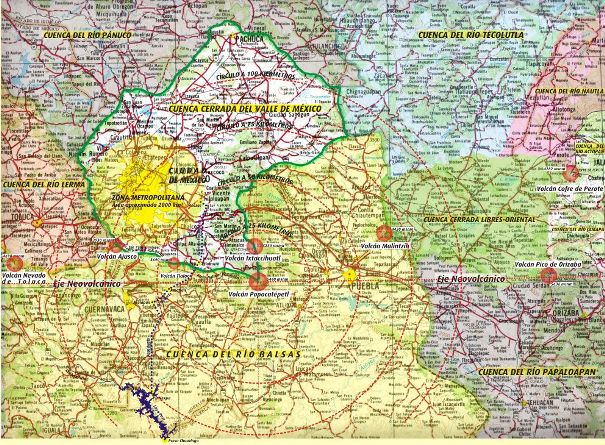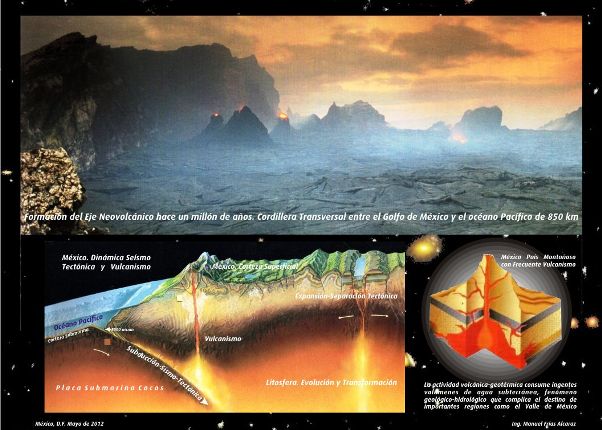Mexico City Valley. Popocatepetl Volcano
Consider Mexico’s geographic
location, it is situated at the epicenter and pivoting point of the former
super-continent, Pangaea. Its location is at the center of what used to be all
six continents in one. These matter, energy and geo-dynamic evolution created a
lithosphere full of unique structures, reliefs and configurations. For instance,
the Yucatan Peninsula is the only north-facing peninsula in the world, while the
Baja California peninsula, is the longest south-facing peninsula. Both acting as
gigantic natural pendulums.
Mexico is divided in the middle by two distinct
geologic platforms combined into one neo-volcanic system, located in the middle
of the Americas, at the top of the Cocos/Ring of Fire tectonic plate and a
parallel to the Equator (at approximately 850 km). The newly-emerged volcanic
ridge formed a million years ago, is equivalent to a huge natural dam that
changed the hydrology of several basins.
Central Region. The
Popocatepetl/Ajusco neo-volcanic system formed a 70-km long volcanic dam
transforming the Mexico City Valley into a closed basin without a natural outlet
to the sea.
The geological activity in the Popocatépetl volcano results in the
evaporation of large volumes of groundwater (regularly forming steam clouds), a
phenomenon that is thought be a tendency to shorten the habitability of the
Mexico City Valley and Puebla. Its chimney is nearly seven acres across and
frequently ejects incandescent material, gases, minerals, ash and water
steam.The exhaling takes place when large volumes of water from regional aquifers are sucked in by the volcano reducing the availability of ground water, which in return, causes ground subsidence (40 centimeters per year), voids, cracks, fractures, flooding and infiltration of waste water onto plateau.
The Popocatepetl Geo-thermoelectric Project (PGT), located in Puebla and Mexico States, is conceptualized; planned and developed around productively, optimally and objectively exploit the valuable, strategic and endless endogenous heat and steam to generate electric power. As well as to taking advantage of hydroponics to extend the alternatives for farming.
The above would be accomplished by setting up three very safe geothermal complexes or sites: Huitlostoc, Tlamacas and Xalipilcayatl. Each located at 3900 meters above sea level and four kilometers from the volcano crater.
It is evident that there are multiple risks associated with setting up such complexes in active-volcano areas. But, by transforming this form of energy into an endless source of clean energy, it would save a tremendous amount of hydrocarbons (oil, natural gas, fuel oil, and diesel), coal, and uranium. While on the economic side of it, energy and capital investments would rise their value and competitiveness by it almost immediately.
The complexes would feature inclined wells directed towards the volcano chimney. These wells would vary in length, from 3820m to 5660m depending on the inclination of the actual slope. The high-pressure, high-temperature steam flow, which is currently around 30 m³/s would be more than enough power to supply to the actual geothermal plants running sets of large turbo-generators (between 500 MW and 750 MW).

Neo-volcanic mountain range.
Geo-thermal activity and tectonic subduction. Popocatepetl Volcano: 5440m above
sea level.
It is a fact that the constant geothermal activity of the volcano is both, a
threat, and a tremendous opportunity to continuing progress. By extracting and
channeling part of the volcano’s endogenous energy, there would be a notable
increase in natural gas supply overall and significantly reduce the use and
consumption of hydrocarbon resources currently used by the electric (CFE) oil
(PEMEX) industries.Thus, the ability to drill the wells at an incline is at the very essence of the PGT project. With diameters ranging from one meter (40 inches to start) to 25cm (10 inches in the vicinity of the chimney), drilling for these geothermal wells will require innovation, new development and updated construction processes.

Popocatepetl Volcano. Huge water
evaporation and groundwater consumption (about 30 cubic meters per second) of
the aquifers in the valleys of Mexico and Puebla. Cloud
formation.
Hence, it would be a priority to properly exploit the Huitlastoc, Tlamacas
and Xalipilcayatl complexes, both, for energy, technical and economic
advantages, as well for representing the possibility of leaving behind the
current primary sources of energy, such as oil, natural gas, coal, diesel,
uranium, etc.The invaluable gift that the Popocatepetl volcano represents to the middle region of Mexico should be put to work immediately as opposed to be seen as a constant danger or threat. By implementing well-conceptualized, defined and coordinated plans and programs to use this energy resource, it would help sort and redirect development in the sector.
The amount of steam produced by the volcano makes it very attractive to install high-capacity power generation facilities. For instance, for each 1000 Megawatts used, there is a potential to generate 7440 Gigawatts·hour annually in return, which represent similar production numbers to those of the Laguna Verde Nuclear Power Plant in Veracruz or the Power Plant in Tula, Hidalgo, but in this case, using a renewable and unlimited resource. Also, by doing so, the industry would replace 12.40 million barrels of fuel oil, 1.715-million m³ of natural gas, 3.72-million tons of coal, or 3.724-billion liters of diesel, which more and more are sourced from overseas suppliers.
Based on this information, the output and power production of the proposed geothermal plants would get multiplied by the thousands.
Popocatépetl Geo-thermoelectric Project.
Savings and Substituting Fuel.
|
Power Output Megawatts
|
Annual Production GW·h
|
Fuel. Savings in barrels x
106
|
Natural Gas. Savings in m³ x
106
|
Coal. Savings in tons x 106
|
Diesel. Savings in litters x
106
|
|
500
|
3723
|
6.20
|
857
|
1.86
|
1862
|
|
750
|
5585
|
9.30
|
1285
|
2.79
|
2793
|
|
1000
|
7450
|
12.41
|
1715
|
3.72
|
3724
|
|
2000
|
14900
|
24.83
|
3428
|
7.44
|
7448
|
|
3000
|
22338
|
36.75
|
5140
|
11.16
|
11172
|
|
4000
|
29800
|
49.64
|
6860
|
14.88
|
14896
|
|
5000
|
37250
|
62.05
|
8575
|
18.60
|
18620
|
Popocatepetl Geo-thermoelectric Project.
Geothermal Fields
|
Concept
|
G.F. Huitlastoc
|
G.F. Tlamacas
|
G.F.
Xalipilcayatl
|
|
Distance to crater
|
3850m southwest
|
4000m north
|
3750m northeast
|
|
Altitude (meters above sea level, masl)
|
3985
|
3860
|
3820
|
|
Latitude (north)
|
19° 00’ 34”
|
19° 03’ 31”
|
19° 02’ 08”
|
|
Longitude (west)
|
98° 39’ 22”
|
98° 37’ 28”
|
98° 35’ 23”
|
|
15°-inclined wells (length and depth)
|
from 3985m to 2953 masl
|
from 4141m to 2788 masl
|
from 3882m to
2815 masl
|
|
30°-inclined wells (length and depth)
|
from 4445m to 1762 masl
|
from 4620m to 1550 masl
|
from 4330m to
1655 masl
|
|
45°-inclined wells (length and depth)
|
from 5445m to 135 masl
|
from 5657m to
-140 masl
|
from 5303m to
70 masl
|
If the convenient and strategic energy reserve in the Popocatepetl Volcano is not creativity transformed, it will continue evaporating and consuming large volumes of groundwater and be considered a latent danger.
It is clear that the Mexico City Valley is headed for collapse if no action is taken. Its 20-million inhabitants’ growing demand for water, the centralism, conurbation and territorial expansion (over 2000 km²) are at fault.
The PGT coupled with National Project México Tercer Milenio, particularly, the Amacuzac Chauzingo Valle de Mexico Project (ChAVM) would be the perfect solution to avoid this unflattering fate.

Inclined geo-thermal wells directed
toward the volcano chimney. Endogenous heat and steam
reservoir.
It is up to the public and the private and social sector with shared
investment and development goals and objectives to put into effect a consistent
and well-planned infrastructure project based on vast, continuous and safe
electricity and food production. This project is aimed at replacing demand for
imported fossil fuels and save non-renewable resources, not to mention, large
amounts of money.The PGT Popocatepetl is an innovative, viable and unique project, which based on its fundamentals, functions and contributions, will become an enduring and profitable business for Mexico.
Manuel Frias Alcaraz
Author of the Nationwide Project México Tercer Milenio (www.mexicotm.com)
Mexico, DF October 2012
© México Tercer Milenio. Documents, plans, programs, and all materials.

No hay comentarios:
Publicar un comentario